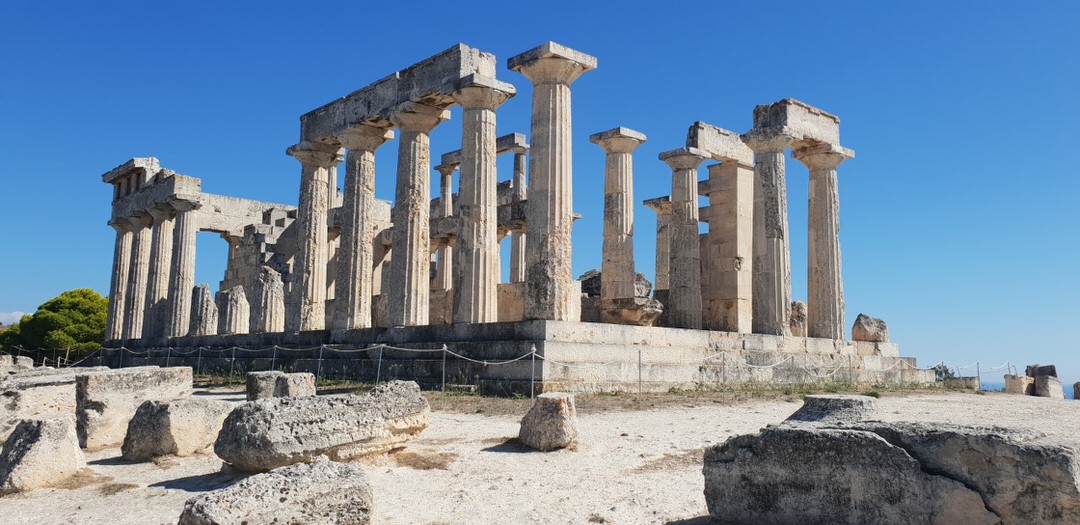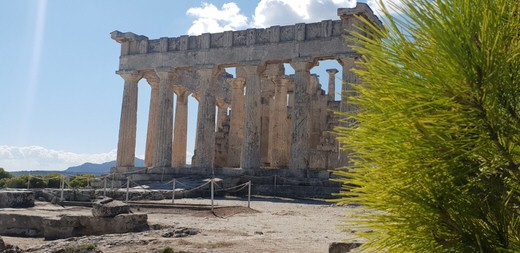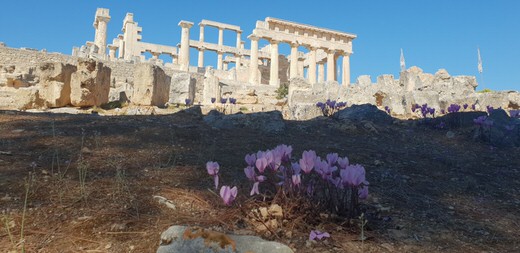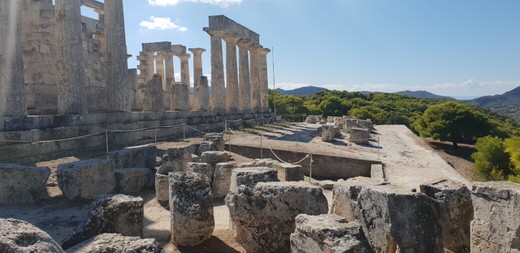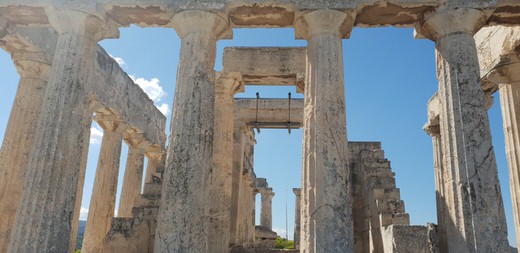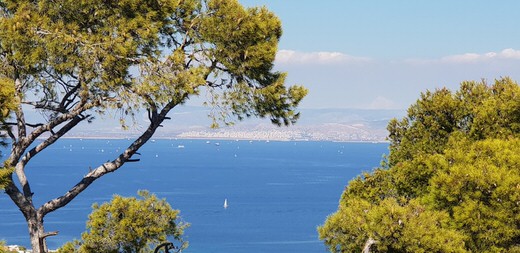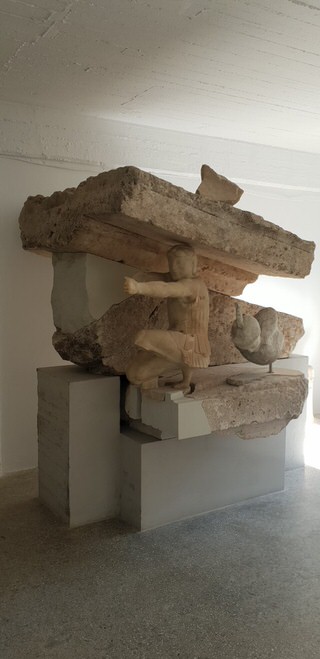An island –ancient city state at the time- during its political and cultural peak. A masterpiece of ancient Doric architecture. Set on a marvelous, pine plant hill, site of a smaller predecessor. Dedicated to a nymph, daughter of Zeus, who was only worshiped on this island. In a simple, doric description, this would give a visitor an idea of the most significant archaeological site and important attraction of Aegina. But the awe and wonderment you feel not only when you stand among the ancient ruins, but also as you approach the 160m hill on which the temple of Aphaia is built, is overwhelming and justifies an opulent description of the overall experience, perhaps the most significant one you’ll have when visiting Aegina.
Ancient Aeginetans couldn’t have chosen a more impressive site for Aphaia’s worship. You realise this as you drive among pine forests, leaving the sandy beach of Agia Marina behind you and ascending the hill. Its peak was the special location that was selected for Aphaia’s first temple, one of the oldest stone, Doric buildings in Greece, which was built around 570 B.C. It was a richly coloured structure that stood there for half a century, before it was destroyed by fire. Unfortunately, none of the elaborate marble statues, dedicated to Aphaia and created in the workshops of local sculptors, were saved and the temple itself was damaged to such an extent that its demolition was decided. The removal of the ruins gave way to a new, grander temple and sanctuary.
The sanctuary and the worship of Aphaia
Indeed, by 490 B.C. a new structure with broadened worship buildings was completed. The entrance was on the south side and consisted of a gateway built of limestone ashlar blocks and two open porches supported by a pair of columns. From there, four steps led up to the level of the temple terrace. In front of the temple to the east, lay the sacrificial altar: a raised table with wing walls protecting it from the winds and a rectangular pavement for the preparation of the sacrifice. The altar and the temple were connected by a paved way, while two small porticoes nearby were decorated by sculptured figures. A high column, probably topped by a marble sphinx, stood on the north side of the temple terrace. A nearby cistern collected rain water from the temple’s roof, while a few houses in front of the sanctuary served as priests’ residence. These were built outside the boundary wall that surrounded the temple terrace and were only accessible from the outside.
The temple, symbol of Aegina
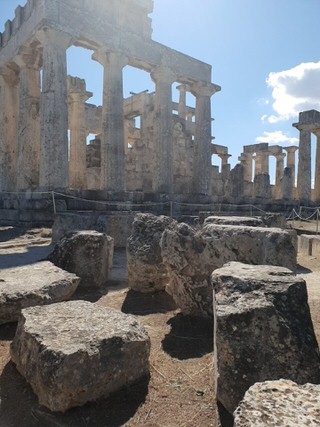
The temple itself was a state of the art structure, so striking at its time that is believed to have inspired the architects of Parthenon. Standing on a three-stepped base, the temple’s plan adopts Doric architecture with 12 pillars in the long and 6 in the narrow sides, of which 24 remain in place today. In contrast to what the visitor sees these days, the temple’s upper part was decorated with bright colours: red in the horizontal parts and black in the vertical elements. The cella, inside the temple, was then place were Aphaia’s wooden and marble worshipping statue stood, along with the nymph’s ivory statue that was saved from the older temple.
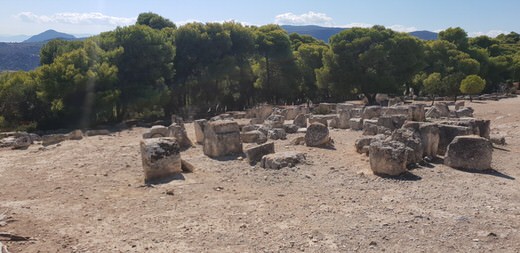
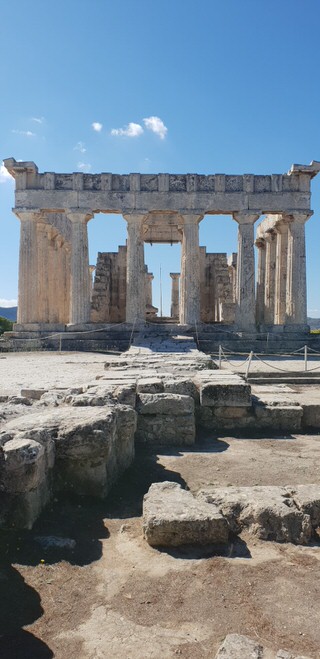
Apart from the impressive structure, the temple had been particularly famous for its pediments of the narrow sides that were decorated with colourful sculptures. And while the temple’s columns are made of local limestone, pure marble from Paros island was used for the pediments and stories from the Trojan war provided the material for their decoration. Both of them depict scenes with ancient Greek gods and heroes descended from the gods, along with ancient Aeginetan heroes who beat the Trojans twice. In the east pediment, Telamon, grandson of Zeus and son of Aiakos who was Aigina’s king, along with his friend Hercules are depicted in battle with Trojan King Laomedon, who was fatally wounded by Hercules’s arrow. In the middle of the pediment, ancient goddess Athena overlooks the battle scene. Athena is also present in the west pediment’s sculptures, this time observing a battle from the second Trojan war, between Ajax, son of Telamon and Aegina’s most glorified hero, and probably Hector, prince and leader of Trojans. Unfortunately, none of these marvelous works of art that were evidence of the locals’ sculpting skills, remain in their original environs today. The 19th century excavations resulted in removing and taking the pediments to Italy, and from there sold to King Ludwig I of Bavaria, great lover of Greek art. Today, after restoration, they are exhibited in the Glyptothek of Munich and only fragments are displayed in the temple’s museum and on the archaeological site.
A visit to the museum
In order to develop a better understanding of the temple’s history and admire some of the findings of the site, don’t miss the visit to the small museum that operates in the sanctuary’s area. You will find detailed information about the old temple, the new temple’s construction and how Aegina’s loss of independence led to the sanctuary’s decline. First of all, you will be able to observe a small scale model representing the first temple, along with designs and information about it. As you move further on, models of parts of the new temple have been set up to exhibit in their original place fragments and parts that have been excavated. Statues and statuettes, ceramic vessels and dedications complete the storytelling of the archaeological site’s history.
There’s no better way to conclude your visit to Aphaia’s archaeological site than spending some time in the surrounding area, sitting among the ancient ruins and enjoying the serenity of the scenery and the view towards the Saronic gulf with Athens in the far distance. This distance between the vast Greek capital and Aegina seems so short, but the quietness of the area and nature all around you, makes you feel so detached from city life. There, on the hill top, the green of the pine forest and the blue of the sea become one and you only need to breath in the fresh air and take a look at the wild cyclamens around you, to realise why this special place was chosen as a nymph’s worship place.

